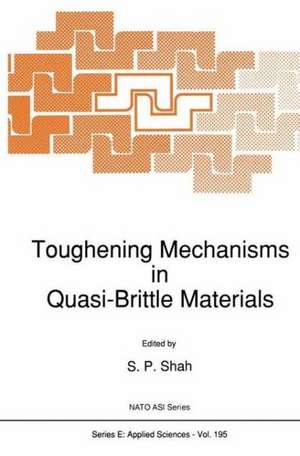Toughening Mechanisms in Quasi-Brittle Materials: Topics in Molecular Organization and Engineering, cartea 195
Editat de S. P. Shahen Limba Engleză Hardback – 31 mar 1991
| Toate formatele și edițiile | Preț | Express |
|---|---|---|
| Paperback (1) | 407.19 lei 43-57 zile | |
| SPRINGER NETHERLANDS – 5 noi 2012 | 407.19 lei 43-57 zile | |
| Hardback (1) | 601.09 lei 43-57 zile | |
| Kluwer Academic Publishers – 31 mar 1991 | 601.09 lei 43-57 zile |
Preț: 601.09 lei
Preț vechi: 707.16 lei
-15% Nou
Puncte Express: 902
Preț estimativ în valută:
115.02€ • 120.39$ • 95.73£
115.02€ • 120.39$ • 95.73£
Carte tipărită la comandă
Livrare economică 31 martie-14 aprilie
Preluare comenzi: 021 569.72.76
Specificații
ISBN-13: 9780792311980
ISBN-10: 0792311981
Pagini: 186
Greutate: 1.05 kg
Editura: Kluwer Academic Publishers
Seria Topics in Molecular Organization and Engineering
Locul publicării:Dordrecht, Netherlands
ISBN-10: 0792311981
Pagini: 186
Greutate: 1.05 kg
Editura: Kluwer Academic Publishers
Seria Topics in Molecular Organization and Engineering
Locul publicării:Dordrecht, Netherlands
Public țintă
ResearchCuprins
Session 1: Fracture of Ceramics with Process Zone.- Fracture Properties of SiC-Based Particulate Composites.- Crack Bridging Processes in Toughened Ceramics.- Fracture Process Zone in Concrete and Ceramics - A Matter of Scaling.- Report on Session 1: Fracture of Ceramics with Process Zone.- Session 2: Fracture in Concrete and Rock.- Microcracking and Damage in Concrete.- Cracking, Damage and Fracture in Stressed Rock: A Holistic Approach.- Test Methods for Determining Mode I Fracture Toughness of Concrete.- Report on Session 2: Fracture in Concrete and Rock.- Session 3: Theoretical Fracture Mechanics Considerations.- Rate Effect, Size Effect and Nonlocal Concepts for Fracture of Concrete and Other Quasi-Brittle Materials.- Micromechanics of Deformation in Rocks.- Asymptotic Analysis of Cohesive Cracks and its Relation with Effective Elastic Cracks.- Reporter’s Summary: Session 3, Theoretical Fracture Mechanics Considerations.- Session 4: Experimental Observations.- Microstructure, Toughness Curves and Mechanical Properties of Alumina Ceramics.- Creep Damage Mechanisms in Hot-Pressed Alumina.- Study of the Fracture Process in Mortar with Laser Holographic Measurements.- Reporter’s Comments on Session 4 - Experimental Observations.- Session 5: Experimental Methods to Assess Damage.- The Fracture Process Zone in Concrete.- Characterization of the Fracture Behavior of Ceramics Through Analysis of Crack Propagation Studies.- A Review of Experimental Methods to Assess Damage During Fracture of Rock, Concrete and Reinforced Composites.- Similarities Between Fracture Processes in Concrete, Rock and Ceramics: Recorders Report to Session 5 ‘Experimental Methods to Assess Damage.- Session 6: Theoretical Micromechanics Based Models.- A Review of Some Theories of TougheningMechanisms in Quasi-Brittle Materials.- On the Form of Micromechanical Models of the Brittle Deformation of Solids.- On the Relationship Between Fracturing of A Microcracking Solid and its Effective Elastic Constants.- Report of Session 6: Theoretical Micromechanics Based Models.- Session 7: Fracture Process in Fiber Reinforced Ceramics.- Determination of Fiber-Matrix Interfacial Properties of Importance to Ceramic Composite Toughening.- Quasi-Ductile Behaviour of Carbon-Reinforced Carbon.- The Fracture Resistance and Brittle Matrix Composites.- Session 7 Discussion.- Session 8: Fracture Toughness of Fiber-Reinforced Cement Composites.- Research Challenges in Toughness Development of Fiber Reinforced Cementitious Composites.- Failure Characterisation of Fibre-Reinforced Cement Composites with R-Curve Characteristics.- Characterization of Interfacial Bond in FRC Materials.- Summary of Session 8: Fracture Toughness of Fiber-Reinforced Cement Composites.- Session 9: Strain Rate, Thermal, Time and Fatigue Effects.- Growth of Discrete Cracks in Concrete under Fatigue Loading.- Creep and Creep Rupture of Structural Ceramics.- Fracture of Concrete at High Strain-Rate.- Summary of Session 9: Strain Rate, Thermal, Time, and Fatigue Effects.- Author Index.


































